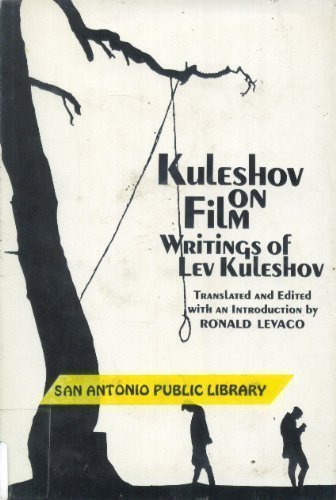Kuleshov on Film: Writings by Lev Kuleshov ebook
Par brainerd thelma le vendredi, avril 8 2016, 23:26 - Lien permanent
Kuleshov on Film: Writings by Lev Kuleshov. Lev Vladimirovich Kuleshov, Ronald Levaco

Kuleshov.on.Film.Writings.by.Lev.Kuleshov.pdf
ISBN: 0520026594,9780520026599 | 121 pages | 4 Mb

Kuleshov on Film: Writings by Lev Kuleshov Lev Vladimirovich Kuleshov, Ronald Levaco
Publisher: Univ of California Pr
The year after The Gold Rush and Battleship Potemkin, Eisenstein's teacher Kuleshov turned in his own gold rush masterpiece. Originally known as the Trailer Park, the contest has been renamed after the Kulsehov Effect, a study in the impact of film editing on viewers by Russian film maker Lev Kuleshov in the 1920s. At first, I had Mozhukhin “From 1918 on we studied film writing, or how to write with a camera. Among aficionados of early silent films, Lev Kuleshov, the Soviet film director, is known for his use of editing to evoke different emotions. Although Lev Kuleshov was the first to experiment with Montage, Eisenstein argued that the collision between two adjoining images creates a third meaning. These studies began a continuous line of European philosophical works on film that stretched through to today's writings by Jacques Rancière and Slavoj Žižek. Lev Kuleshov was an early Soviet director, possibly one of the first film theorists of montage, who worked prior to Eisenstein's appearance in film. We were ignorant, and suffered from the absence of a film-alphabet. Doublier, described as “the spiritual ancestor” of Lev Kuleshov, the Soviet montage theorist, uses the metaphoric properties of film to analogize the event where images do not exist. Source: http://www.imdb.com/name/nm0474487/bio : accessed on 12/9/2012. He also started moving the cameras. There was a lot more action in this film and he followed the action throughout the story. The idea that editing constitutes the “essence” of film art originated with the Russian director and theoretician Lev Kuleshov (1899-1970) who experimented with montage in the 1920s in an almost scientific fashion and is also one of the key exponents of the 'film as language' idea. Soviet film makers of the 1920s like Kuleshov, Pudovkin, and Sergei Eisenstein all were founding fathers of montage, although it is argued that Eisenstein defined. Lev kuleshov was among the very first to theorise about the relatively young medium of the cinema in the 1920s. He said editing should make people think, not just see what they see. By 1919 Lev Kuleshov had already started to make fundamental experiments to push the use of montage, and formulated what has come to be known as the “K” effect: “From old films I took shots of the actor Mozhukhin and edited them with various other shots. This technique, described by critic Paul Arthur as “metaphoric The diametrical separation between films critically assembled from newsreels and the formalist “played film” frequently appears in the writings of Soviet editors. The inevitable day eventually comes in film school in which one learns the famed and much-debated Kuleshov Effect.